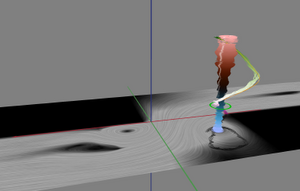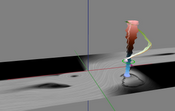Information
- Publication Type: Bachelor Thesis
- Workgroup(s)/Project(s):
- Date: December 2021
- Date (Start): 12. February 2021
- Date (End): 23. December 2021
- Matrikelnummer: 11809612
- First Supervisor: Eduard Gröller
Abstract
Scientists and engineers from many domains work with fluid simulation and visualization. These tools help to understand physical phenomena like vortices that occur as weather phenomena, in ocean currents and in aerodynamics. The visualization of flow fields profits from advanced concepts like observer relativity. Existing interactive frameworks for observer-relative visualization need to pre-process the flow data to obtain meaningful reference frames. This pre-processing task is computationally expensive and potentially time consuming for large data sets. In this thesis a method without pre-processing is proposed. Starting at a user specified location we iterate the optimization of the observer field in a small subset of the data, and the integration of the observer worldline to find the next start location. The visualization of the observed pathlines is interleaved with the observer-calculation. The combination of progressive buildup, as well as low-level optimization techniques like caching, prediction, and parallelization, provides an algorithm that visualizes observer-relative flow interactively without the need of pre-processing. The avoidance of pre-processing makes this technique suitable for in-situ scenarios, and for the exploration of the parameter space of optimization techniques that are needed to compute reference-frame candidates.Additional Files and Images
Weblinks
No further information available.BibTeX
@bachelorsthesis{Woschizka_2021,
title = "Interactive Reference-Frame Computation for
Observer-Relative Flow Visualization",
author = "Bernhard Woschizka",
year = "2021",
abstract = "Scientists and engineers from many domains work with fluid
simulation and visualization. These tools help to understand
physical phenomena like vortices that occur as weather
phenomena, in ocean currents and in aerodynamics. The
visualization of flow fields profits from advanced concepts
like observer relativity. Existing interactive frameworks
for observer-relative visualization need to pre-process the
flow data to obtain meaningful reference frames. This
pre-processing task is computationally expensive and
potentially time consuming for large data sets. In this
thesis a method without pre-processing is proposed. Starting
at a user specified location we iterate the optimization of
the observer field in a small subset of the data, and the
integration of the observer worldline to find the next start
location. The visualization of the observed pathlines is
interleaved with the observer-calculation. The combination
of progressive buildup, as well as low-level optimization
techniques like caching, prediction, and parallelization,
provides an algorithm that visualizes observer-relative flow
interactively without the need of pre-processing. The
avoidance of pre-processing makes this technique suitable
for in-situ scenarios, and for the exploration of the
parameter space of optimization techniques that are needed
to compute reference-frame candidates. ",
month = dec,
address = "Favoritenstrasse 9-11/E193-02, A-1040 Vienna, Austria",
school = "Research Unit of Computer Graphics, Institute of Visual
Computing and Human-Centered Technology, Faculty of
Informatics, TU Wien ",
URL = "https://www.cg.tuwien.ac.at/research/publications/2021/Woschizka_2021/",
}

 Bachelor theses
Bachelor theses image
image

